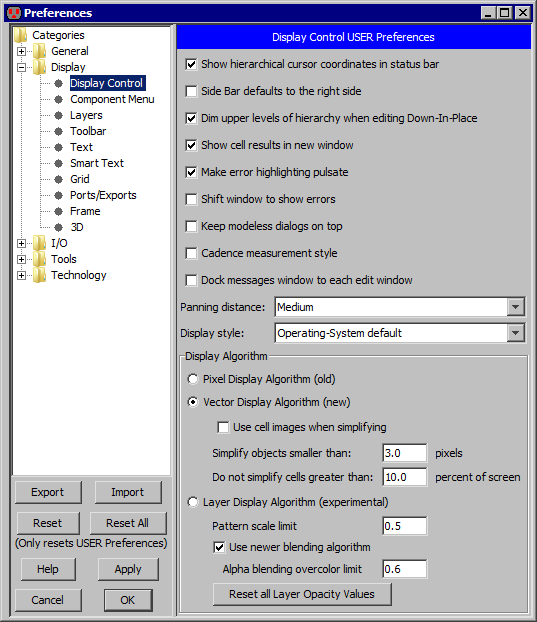New windows are created by checking the appropriate checkbox in the New Cell... or Edit Cell... commands (in menu Cell). New windows can also be created from the cell explorer by using the context menu on a cell name.
All of the windows are listed at the bottom of the Window pulldown menu, including the Messages Window. To bring a window to the top for editing, select its name from this list. To cycle through the different windows, type "q".
To delete a window, click its close box, or use the Close Window command (in menu Window). Note that you cannot delete the last window on systems where the pulldown menu is inside of each window, because then the pulldown menus would become unavailable.
When there are many editing windows on the display, you can arrange them neatly with the Window / Adjust Position commands. The Tile Horizontally command adjusts the windows so that they are full-width, but just tall enough to fill the screen, one above the other. The Tile Vertically command adjusts the windows so that they are full-height, but just wide enough to fill the screen, one next to the other. The Cascade command adjusts the windows so that they are all the same size and overlap each other uniformly from the upper-left to the lower-right.
When Electric runs on the Windows operating systems, each editing window lives inside of a larger frame on the display. This is called an MDI (Multiple Document Interface) interaction. On non-Windows systems (UNIX/Linux, Macintosh, etc.) each editing window is a separate frame on the display. This is called an SDI (Single Document Interface) interaction. Note that Windows users can request an SDI interaction, and non-Windows users can request MDI interaction. This is done with command-line switches (see Section 1-3).
When running in SDI mode, there are two extra commands (in menu Windows) for controlling the frames:
Electric offers many settings for controlling the display, available in the Display Control Preferences (in menu File / Preferences..., "Display" section, "Display Control" tab).

The status area at the bottom of the screen shows current selection, cursor coordinates, etc. If "Show hierarchical cursor coordinates in status bar" is checked, it will also show global coordinates when traversing the hierarchy.
The side bar can be set to always show on the right by checking "Side Bar defaults to the right side". See Section 1-7 for more on the side bar.
When editing "down-in-place", the upper levels of hierarchy are dimmed. Some displays find this difficult to do and draw slowly in down-in-place mode. This is particularly noticeable on X Window systems that use Xorg and Xinerama. To disable the dimming and speed the display, uncheck "Dim upper levels of hierarchy when editing Down-In-Place". See Section 3-5 for more on down-in-place editing.
Many commands cause cells to be displayed in a new window. If you uncheck "Show cell results in new window", then the cells are shown in the current window instead.
When errors are highlighted, the highlighting pulsates to make the error more visible. To disable pulsating highlighting, uncheck "Make error highlighting pulsate".
Another error display control is "Shift window to show errors" which requests that the window pan and zoom to focus on the error. When this is not checked, errors that are off-screen cause an arrow to briefly display indicating the direction of the error.
Many dialogs are "modeless" meaning that they can remain up while other work is done. These modeless dialogs can be covered by the editing windows. Checking "Keep modeless dialogs on top" forces these dialogs to always remain visible.
The Measurement tool is used to show distances (see Section 4-7-4). Checking "Cadence measurement style" requests that it draw rulers similar to Cadence systems.
The "Dock messages window to each edit window" requests that the messages window be attached to the edit window, instead being a separate window.
When panning the window using menu commands, the distance to pan can be controlled with the "Panning distance" selection (see Section 4-4-2 for more on panning).
The "Display style" controls whether Electric uses the MDI (Multiple Document Interface) or the SDI (Single Document Interface) style of interaction. MDI (used typically on Windows systems) uses a single large window that has all of the editing windows inside of it. SDI (used typically on Linux and Macintosh systems) creates a window for every editing window in Electric. You can leave the default style for your operating system, or you can override that and force a style.
Electric has three different display algorithms:
Besides simplifying individual nodes and arcs, Electric also simplifies the display of entire cells if their contents are all too small to draw. Such simplification can consist of rendering the cell with a single "approximating" color, or keeping a small image of the cell and using it in the proper place.
There are some controls for the Vector Display Algorithm. The first control selects whether cell simplification uses an image of the cell or just an approximating color. The next control determines the size at which objects are simplified. The default is to "Simplify objects smaller than 3 pixels". Making this value smaller will cause more detailed drawing, but take longer. The last control determines the threshold for simplifying entire cells. Although a cell's contents may be small, the cell may be quite large on the screen, and so should not be simplified (this happens to top-level cells in a deep hierarchy). The default limit is to "Do not simplify cells greater than 10 percent of the screen". Making this number smaller causes more cells to be drawn fully. Making this number zero turns off cell simplification.
| Previous | Table of Contents | Next |